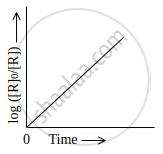Advertisements
Advertisements
प्रश्न
Which radioactive isotope would have the longer half-life 15O or 19O? (Given rate constants for 15O and 19O are 5.63 × 10–3 s–1 and k = 2.38 × 10–2 s–1 respectively.)
विकल्प
15O
19O
Both will have the same half-life
None of the above, information given is insufficient
उत्तर
15O
Explanation:
The rate constant for the decay of 15O is less than that for 19O. Therefore, the rate of decay of 15O will be slower and will have a longer half-life.
APPEARS IN
संबंधित प्रश्न
Calculate the half-life of a first order reaction from the rate constant given below:
200 s−1
During nuclear explosion, one of the products is 90Sr with half-life of 28.1 years. If 1μg of 90Sr was absorbed in the bones of a newly born baby instead of calcium, how much of it will remain after 10 years and 60 years if it is not lost metabolically.
The rate constant for the first order decomposition of H2O2 is given by the following equation:
log k = 14.34 − 1.25 × 104 K/T. Calculate Ea for this reaction and at what temperature will its half-period be 256 minutes?
The half-life period of zero order reaction A → product is given by
(a) `([A]_0)/k`
(b) `0.693/k`
(c) `[A]_0/(2k)`
(d) `(2[A]_0)/k`
A first order reaction takes 10 minutes for 25% decomposition. Calculate t1/2 for the reaction.
(Given : log 2 = 0.3010, log 3 = 0.4771, log 4 = 0.6021)
Show that the time required for 99% completion is double of the time required for the completion of 90% reaction.
For the first order reaction, half-life is equal to ____________.
Calculate half-life period of life order reaction whose rate constant is 200 sec–1
A first-order reaction takes 69.3 min for 50% completion. What is the time needed for 80% of the reaction to get completed? (Given: log 5 = 0.6990, log 8 = 0.9030, log 2 = 0.3010)
Observe the graph shown in figure and answer the following questions:

Write the relationship between k and t1/2 (half-life period)
